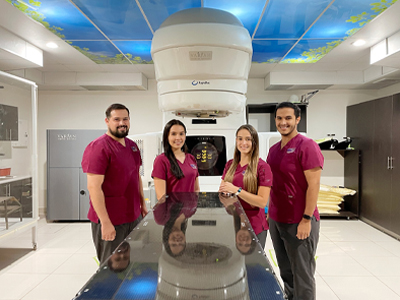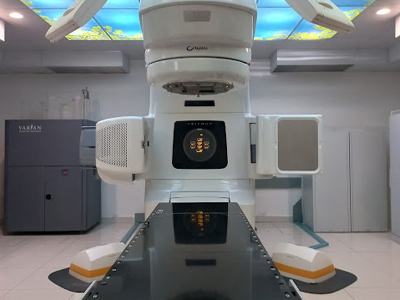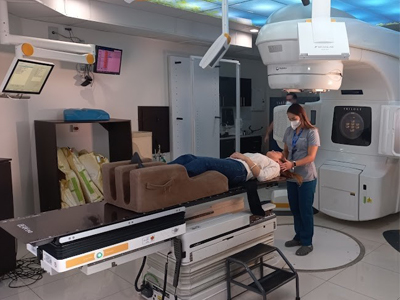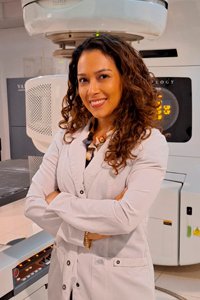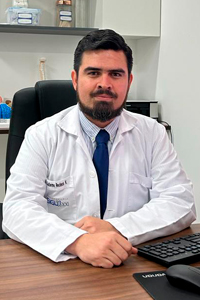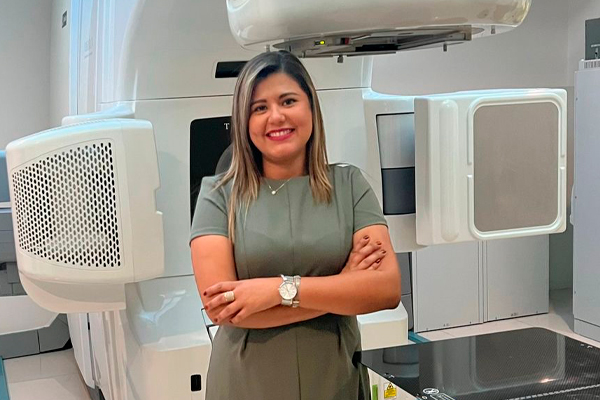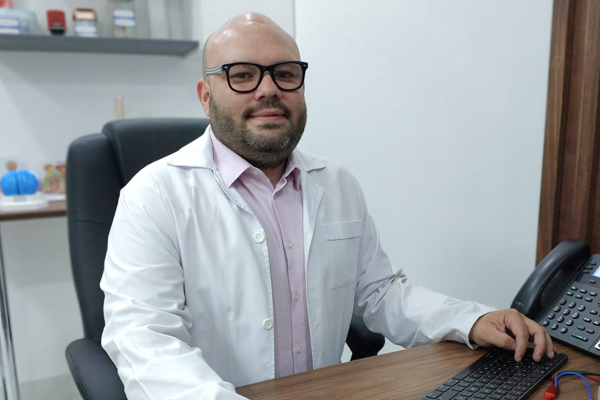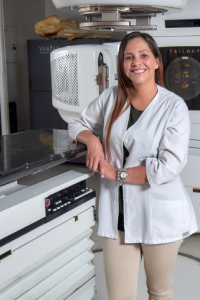Radiocirugía Estereotáxica Craneal
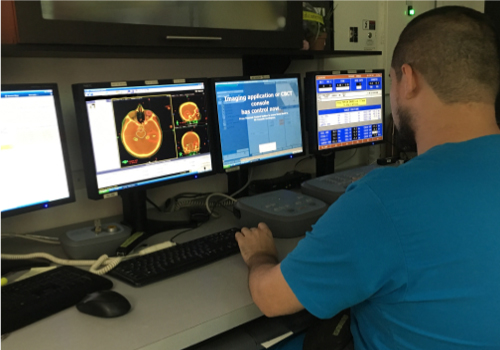
¿Quiénes participan en este procedimiento y quien maneja el equipo?
El equipo de tratamiento está compuesto por varios profesionales médicos especializados, que típicamente son oncólogos radioterapeutas, un físico médico, imagenólogos, un dosimetrista y una enfermera de radioterapia.
- El oncólogo radioterapeuta y en algunos casos, un neurocirujano encabezan el equipo de tratamiento y vigilan el tratamiento; bosquejan las áreas objetivas a tratarse, deciden la dosis apropiada de radiación, aprueban el plan de tratamiento, e interpretan los resultados de los procedimientos radioquirúrgicos.
- Un imagenólogo interpreta las imágenes que identifican las áreas objetivas a tratarse en el cerebro o en el cuerpo.
- El médico físico de radiación asegura la entrega de la dosis precisa de radiación.
- El físico, o un dosimetrista bajo supervigilancia del físico, usa software de computadora especial para preparar un plan de tratamiento; calcula las exposiciones y configuración del haz para tratar las áreas conformalmente a la dosis prescrita.
- Un imagenólogo altamente entrenado posiciona el paciente en la mesa de tratamiento y opera la máquina de un área adyacente protegida.
- El imagenólogo puede observar al paciente a través de una ventana o por una televisión de circuito cerrado y puede comunicar con el paciente durante todo el procedimiento. En el caso de la bisturí de rayos gamma, el neurocirujano y/o el radioncólogo pueden ayudar a posicionar el paciente para el tratamiento y el imagenólogo puede operar la máquina.
- La enfermera de radioterapia evalúa al paciente, proporciona al paciente información sobre el tratamiento, vigila al paciente durante el tratamiento y ayuda a contestar preguntas después del tratamiento.
- Un neurólogo o neuroncólogo puede participar con el oncólogo radioterapeuta y neurocirujano en el equipo multidisciplinario que considera varias opciones de tratamiento para casos individuales y ayuda a decidir quien puede beneficiarse de la radiocirugía para lesiones en el cerebro.
Preparaciones especiales necesarias para el procedimiento
Por lo general, se realizan en forma ambulatoria. Sin embargo, es mejor prepararse para pasar entre un medio día o más en el departamento de imágenes. Se le informará sobre si será necesario que tenga alguien que le acompañe y que le lleve a casa después del procedimiento.
Posiblemente le avisen que no debe comer ni beber nada después de la medianoche antes del tratamiento. Pregúntele a su médico si debe seguir tomando sus medicinas habituales el día del tratamiento y si debe traer sus medicamentos con usted al procedimiento.
Avísele al médico si alguna de las siguientes circunstancias se aplica a su caso:
- Está tomando medicamentos orales o usa insulina para el control de la diabetes.
- Tiene alergia a los medios de contraste intravenosos o yodo.
- Tiene un marcapasos, una válvula cardíaca artificial, un desfibrilador, pinzas para un aneurisma cerebral, bombas o puertos de quimioterapia implantables, neuroestimuladores, implantes de ojo o de oído, stents, bobinas o filtros.
- Sufre de claustrofobia
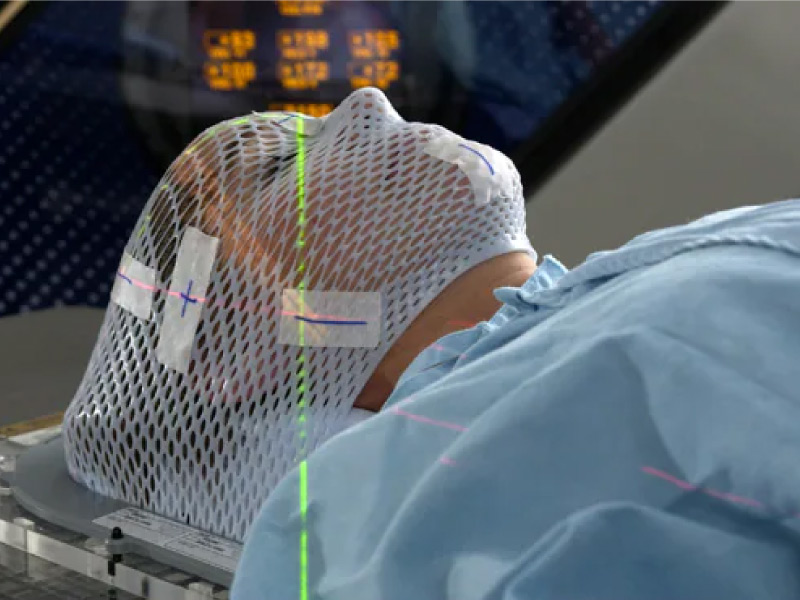
¿Qué se siente durante y después del procedimiento?
Los tratamientos de radiocirugía son similares a la toma de radiografías. Por lo general, los rayos X no se ven, ni se sienten, ni se oyen, con la excepción de los pacientes que están recibiendo un tratamiento en el cerebro, en cuyo caso podrían ver luces mientras la máquina está encendida, incluso con los ojos cerrados. El tratamiento en sí no causa ningún dolor o molestia. Si usted siente dolor por otras razones, como dolor de espalda o incomodidad por el dispositivo de la cabeza o dispositivo de inmovilización, avísele al personal médico o de enfermería.
1- Al quitar el dispositivo de la cabeza podría haber un leve sangrado en los lugares donde se pusieron los tornillos y se cubrirán con un apósito. Si siente dolor de cabeza, puede pedir que le den un medicamento para ayudarle a sentir mayor comodidad.
2- En la mayoría de los casos, los pacientes que se han sometido a la radiocirugía y SRS pueden retomar tomas sus actividades normales dentro de uno o dos días.
3- Los efectos secundarios de la radioterapia incluyen problemas que ocurren como resultado del tratamiento mismo así como del daño hecho por el tratamiento a las células sanas en el área del tratamiento.
4- El número y la severidad de los efectos secundarios que usted experimenta dependen del tipo de radiación y la dosificación que recibe y la parte del cuerpo sometiéndose a tratamiento. Debe hablar con el medico y la enfermera acerca de cualesquiera efectos secundarios que experimenta para que puedan ayudarle a controlarlos.
5- La radioterapia puede causar efectos secundarios tempranos durante o inmediatamente después del tratamiento, y normalmente desaparecen a las pocas semanas. Los efectos secundarios tardíos pueden ocurrir meses o años más tarde. Los efectos secundarios tempranos comunes de la radioterapia incluyen cansancio o fatiga y problemas en la piel. La piel en el área de tratamiento puede ponerse más sensible, roja, irritada o hinchada. Otros cambios en la piel incluyen sequedad, picazón, exfoliación y formación de ampollas.

Según el área sometiéndose a tratamiento, otros efectos secundarios tempraneros pueden incluir:
- Pérdida de pelo en el área de tratamiento
- Problemas en la boca y dificultad en tragar
- Problemas en comer y en la digestión
- Diarrea
- Nausea y vómito
- Dolores de cabeza
- Sensibilidad e hinchazón en el área del tratamiento
- Cambios urinarios y en la vejiga
Los efectos secundarios retardados, que son raros, ocurren meses o años después del tratamiento y a menudo son permanentes. Incluyen:
- Cambios cerebrales
- Cambios en la columna vertebral
- Cambios pulmonares
- Cambios hepáticos
- Cambios en el colon y el recto
- Infertilidad
- Cambios en las coyunturas
- Linfedema
- Cambios en la boca
- Cáncer secundario
- Fracturas en los huesos
Existe un pequeño riesgo de desarrollar cáncer a causa de la radioterapia. Después de radioterapia para cáncer, usted debe someterse a un examen regular por su radioncólogo para detectar cánceres recurrentes y nuevos.
Cuando se usan técnicas tales como la SRS el objetivo es maximizar las capacidades de la radioterapia para destruir el cáncer, mientras se reducen al mínimo sus efectos en los tejidos y órganos sanos, para así evitar los efectos secundarios del tratamiento mismo.

